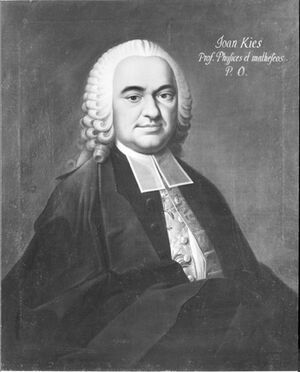Johann Kies facts for kids
Johann Kies (born September 14, 1713, died July 29, 1781) was a smart German scientist. He was an astronomer, who studies stars and planets, and a mathematician, who works with numbers. Kies was born in a town called Tübingen. In 1751, he worked in Berlin with another astronomer, Jérôme Lalande. They studied the Moon's parallax, which is how the Moon seems to shift position when viewed from different places. They did this at the same time as Nicolas Louis de Lacaille, who was observing from the Cape of Good Hope.
Contents
A Professor and Astronomer
From 1742 to 1754, Kies became a professor of mathematics. He taught at Berlin's Academy of Sciences. He was also an astronomer at the Academy's observatory. A famous mathematician named Leonhard Euler suggested him for these important jobs.
During this time, Kies wrote several reports. These reports were about interesting topics like:
- How planets are best positioned to see changes in their movement.
- How the Moon can block out, or eclipse, other stars.
- A description of a special instrument at the Berlin observatory.
Kies believed that watching eclipses was very helpful. He wrote that "Observations on eclipses are extremely useful, especially the ones that are exact." He explained that these observations help scientists understand if their ideas about the Sun and Moon are correct. They can either prove the ideas right or show that they need to be changed.
Teaching and Leadership
After his time in Berlin, Kies also taught at the Collegium of Tübingen. From 1754 to 1755, he was the director of the Astronomisches Rechen-Institut in Heidelberg. This institute was important for calculating the positions of stars and planets.
Sharing New Ideas
Kies was one of the first people to share the discoveries of Isaac Newton in Germany. Newton was a very famous English scientist. Kies wrote two books about Newton's ideas. These books were called De viribus centralibus (published in 1758) and De lege gravitatis (published in 1773). Both were published in Tübingen.
Kies also wrote about how the Moon affects Earth. His work, De influxu lunae in partes terrae mobiles (1769), explored the Moon's influence. He wrote many other books and papers about astronomy. He wrote them in both French and Latin.
Letters with Euler
Kies wrote letters to Leonhard Euler between 1747 and 1767. There are eight letters in total, and all of them were written by Kies.
His Legacy
Today, a crater on the Moon is named after him. It is called Kies.
Sources
- Imago Mundi: Johann Kies
- Euler’s Correspondents
See also
 In Spanish: Johann Kies para niños
In Spanish: Johann Kies para niños


